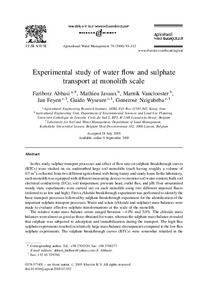| dc.contributor.author | Abbasi, F. |
| dc.contributor.author | Javaux, M. |
| dc.contributor.author | Vanclooster, M. |
| dc.contributor.author | Feyen, J. |
| dc.contributor.author | Wyseure, G. |
| dc.contributor.author | Nziguheba, Generose |
| dc.date.accessioned | 2019-12-04T11:18:34Z |
| dc.date.available | 2019-12-04T11:18:34Z |
| dc.date.issued | 2006 |
| dc.identifier.citation | Abbasi, F., Javaux, M., Vanclooster, M., Feyen, J., Wyseure, G. & Nziguheba, G. (2006). Experimental study of water flow and sulphate transport at monolith scale. Agricultural Water Management, 79(1), 93-112. |
| dc.identifier.issn | 0378-3774 |
| dc.identifier.uri | https://hdl.handle.net/20.500.12478/3251 |
| dc.description.abstract | In this study, sulphur transport processes and effect of flow rate on sulphate breakthrough curves (BTCs) were studied on six undisturbed large soil monoliths (each having roughly a volume of 0.5 m3), collected from two different agricultural soils being loamy and sandy loam. In the laboratory, each monolith was equipped with different measuring devices to monitor soil water content, bulk soil electrical conductivity (ECa), soil temperature, pressure head, outlet flux, and pH. Four unsaturated steady state experiments were carried out on each monolith using two different imposed fluxes (referred to as low and high). First a chloride breakthrough experiment was performed to identify the basic transport processes followed by sulphate breakthrough experiment for the identification of the important sulphate transport processes. Water and solute (chloride and sulphate) mass balances were made to evaluate effective sulphate transformations at the scale of the monolith. The relative water mass balance errors ranged between −4.0% and 5.0%. The chloride mass balances were almost as good as those obtained for water, whereas the sulphate mass balance revealed that sulphate was subjected to adsorption and immobilization during the transport. The high flux sulphate experiments resulted in relatively large mass balance discrepancies compared to the low flux sulphate experiments. The sulphate breakthrough curves (BTCs) were somewhat retarded in the loamy monoliths whereas both chloride and sulphate BTCs were significantly affected by preferential flow in the sandy loam monoliths. Standard batch experiments showed that the adsorption isotherm was linear and immobilization occurred in both soils studied whereas net mineralization was essentially low. The effect of flow rate on the BTCs and influence of water content on immobilization process was not apparent. |
| dc.description.sponsorship | Fonds National de la Recherche Scientifique, Belgium |
| dc.language.iso | en |
| dc.subject | Sulphur |
| dc.subject | Sulphate Transport |
| dc.subject | Solute Transport |
| dc.subject | Mass Balance |
| dc.subject | Adsorption |
| dc.subject | Immobilization |
| dc.title | Experimental study of water flow and sulphate transport at monolith scale |
| dc.type | Journal Article |
| dc.description.version | Peer Review |
| cg.contributor.affiliation | Agricultural Engineering Research Institute, Iran |
| cg.contributor.affiliation | Université Catholique de Louvain |
| cg.contributor.affiliation | Katholieke Universiteit Leuven |
| cg.contributor.affiliation | International Institute of Tropical Agriculture |
| cg.coverage.region | Acp |
| cg.coverage.region | Europe |
| cg.coverage.country | Belgium |
| cg.isijournal | ISI Journal |
| cg.authorship.types | CGIAR and developing country institute |
| cg.iitasubject | Soil Health |
| cg.iitasubject | Integrated Soil Fertility Management |
| cg.iitasubject | Soil Information |
| cg.accessibilitystatus | Limited Access |
| local.dspaceid | 94925 |
| cg.identifier.doi | http://dx.doi.org/10.1016/j.agwat.2005.07.032 |

